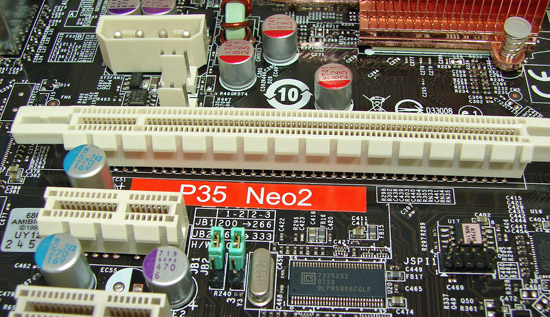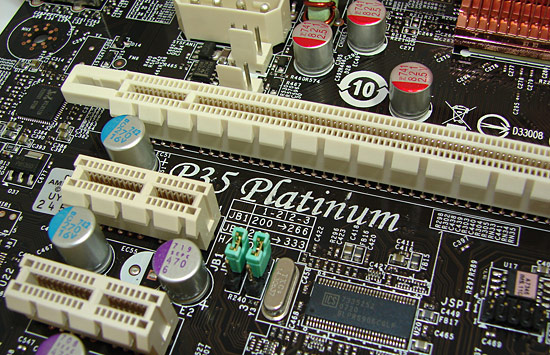MSI P35 Neo2-FR: Platinum performance for under $100
by Gary Key on December 5, 2007 11:00 PM EST- Posted in
- Motherboards
We have not heard that much from MSI lately. Yes, they always seem to launch product at the same time as ASUS and Gigabyte, but their product launches always seem subdued. Their marketing program does not usually have the all-out blitz we typically see from ASUS or Gigabyte, or their product lineup may lack a killer feature. We know MSI is there - in fact, not a day goes by without us discussing products or technology with them - so what's the problem? It comes down to having a product design or feature that differentiates MSI from the other suppliers. No, we are not talking about roller coaster designed heatpipes; we are talking about product that outperforms the competition at launch or can make a difference in how you use or perceive the value of the product.
We have seen a great deal of improvement in MSI's motherboard products over the course of the last year. Their layouts have improved and in fact, we absolutely love the layout on the new K9A2 Platinum board that uses AMD's new 790FX chipset. MSI also offers the Creative Lab's X-Fi audio codecs on their high-end boards as a nod to the gaming community. In addition to unique layouts or features, their overall product quality and commitment to performance has been steadily improving. Our problem with MSI the past few product launches has not centered on them being late to market or not having compelling product alternatives. It has come down to basic performance, compatibility, and BIOS features that leave a lot to be desired when comparing them to the likes of ASUS or Gigabyte. We witnessed this with the P35 launch last spring and again with the 790FX a couple of weeks ago. Their boards are solid and perform well at launch; only the BIOS releases have been weak. The difference we are seeing now is that MSI is quickly resolving problems, and they continue to provide support and updates over the lifespan of the product.


Identical or Fraternal Twins?
The other difference is that MSI is starting to offer a compelling value in certain market segments. One such market segment is the quickly growing budget performance sector, which is now moving to Intel's P35 chipset. The initial launch of the P35 chipset featured boards in the $200 and up price grouping from ASUS, Gigabyte, and MSI. MSI's offering, the P35 Platinum, was at the low end of this sector but did not offer a very good price to performance ratio when compared to the other boards. This changed greatly a few weeks after its release with the P3 performance-oriented BIOS. However, there was an eerie silence at the time as abit had just introduced the similarly priced and very impressive IP35-Pro to a thunderous roar from the user community.
With the introduction of the X38 chipset and the widespread adoption of P35 across a variety of products, we are now seeing incredible competition in the budget to midrange markets. As competition has increased, prices have decreased and the selection of performance-oriented motherboards for under a $130 is incredible. We say this considering the typical prices that usually accompany Intel chipsets. What is even more amazing is the level of performance and features that a user can purchase for under $100 now. We are not talking about the P965 or 945P based boards, but boards designed around the P35 chipset.
MSI offers a base P35 board for around $72, but that board like other budget designs is suited for SOHO users. What excites us in the under $100 performance market are boards like the abit IP35-E and Gigabyte GA-P35-DS3L. Recognizing this trend, MSI developed the Neo2 series. In actuality, they did not have to do too much development; the Neo2-FR/FIR is just a rebadged P35 Platinum with a couple of features missing. MSI is not really hiding this fact; the user can easily remove the Neo2 label to see the Platinum silk screen. The features missing are not extensive either; the FR board drops FireWire and an S/PDIF Optical out port while the FIR is only missing the Optical out port.
Fortunately, for us the performance remains the same, as does the support, features, and quality. The only difference is the almost $40 reduction in price, something we can all use. Let's look at the MSI Neo2-FR feature set and performance results. Our findings might just make you sit up and take notice of MSI again.










35 Comments
View All Comments
drebo - Friday, December 7, 2007 - link
I'll forgive your ignorant comment since you obviously do not work in retail computer sales. People aren't interested in buying adapters and add-on cards that they don't feel they should need because "their old computer had it." In a managed IT environment, yes, you can just give everyone converters and it works fine, but your average joe who walks into a computer shop with a 10-year-old dead computer and an ancient Epson parallel printer isn't ever going to understand why his old connections are going by the way-side.So, yes, legacy support in the retail market is important, even for most small business users. Not a day doesn't go by when I get a call or someone comes in needing a parallel card or serial card because the off-the-shelf computer they bought doesn't come with one. Most people don't need 16 USB ports, but I'll bet a good number do need a parallel port.
AssBall - Saturday, December 8, 2007 - link
"I'll forgive your ignorant comment since you obviously do not work in retail computer sales."Right... because a good retail computer salesperson would sell someone who is inexperienced enough to not RTFM a 10$ adapter instead of reccomending a better and higher profit margin 10 year newer replacement product for 150$ with built in factory support$
Salesman indeed...
kmmatney - Thursday, December 6, 2007 - link
Serial mice? Come-on! I used serial mice back in the day, but there is absolutely no need to get a USB mouse - I just bought a spare optical mouse for $3 at Microcenter - works great. You can get a USB-RS232 adapter for around $15 as well. Or you can buy a PCI add-on card, with RS232 and Parallel ports, for around the same price. I'd way rather have the extra USB and e-Sata ports instead of the legacy crap.I do a lot of RS-232 and RS-485 programming, and my main computer is a laptop, so I've been using USB-Serial converters for some time now.
theslug - Thursday, December 6, 2007 - link
They sell these:http://www.newegg.com/Product/ProductList.aspx?Sub...">http://www.newegg.com/Product/ProductLi...iption=u...
OndrejSc - Thursday, December 6, 2007 - link
Cheer up! It does exist. :-)http://global.msi.com.tw/index.php?func=proddesc&a...">http://global.msi.com.tw/index.php?func...=1342&am...
drebo - Thursday, December 6, 2007 - link
Hmmm, good news. I wonder when we'll have availability and what the pricing will be like.LoneWolf15 - Thursday, December 6, 2007 - link
"MSI also offers the Creative Lab's X-Fi audio codecs on their high-end boards as a nod to the gaming community."No...MSI puts the X-Fi XtremeAudio chip on the boards, which is a tweaked Audigy SE chip (note: the Audigy SE isn't even a true Audigy chip), not a true X-Fi. No hardware EAX or DirectSound3D acceleration, and the drivers, like the X-Fi XtremeAudio card, are completely different than the rest of the X-Fi line. So, serious gamers STILL need to buy a sound card.
I really like MSI and use their boards a lot, but this audio solution is really only slightly better than what is used on other boards --and those who don't like Creative might argue that the drivers actually make it worse. If MSI had used the real X-Fi chip, I'd be very impressed.
ultimatex - Thursday, December 6, 2007 - link
are u retarted ? serious gamers need to buy a seperate sound card? A real serious games would not be worrying about some sound options but more about performace of the board. I smell some Asus Gybabyte fan boys here on these forums.as long as boards have 5.1 sound U dont need no special features that dont do anything specialy for games. Serious games wear headphones.
these NERDS here are sounding like if a serious gamer has to have a sound card . Well ill tell u from a X-Cal P Css Player here. A videocard and Fps is the most important thing for a Hardcore gamer..
Etern205 - Friday, December 7, 2007 - link
Your the retarded one.If he's right and that the onboard X-FI does not have hardware accelerated audio, what it means it it uses the cpu to process the audio singal which leads to reduce FPS. Gamers needs to know where their enemies are and that's where the EAX comes in. Onboard will have EAX as well as mutli-channel speaker support (ie 5.1 surround sound) but without a higher version of EAX (ie EAX 5.0) all your hearing are just sounds coming at you with no sense of direction.
So if you got a 5.1 speaker setup but with a crappy onboard Audio or onboard X-FI with crappy EAX support then it won't help you as much as a dedicated sound card.
dazy - Tuesday, December 11, 2007 - link
Thanks for pointing out his utter ignorance before I had to, lol.[quote=ultimatex]serious gamers need to buy a seperate sound card?
as long as boards have 5.1 sound U dont need no special features that dont do anything specialy for games. Serious games wear headphones.
A videocard and Fps is the most important thing for a Hardcore gamer..[/quote]
The sheer number of stupid statements for a "gamer" in his post is outstanding. Maybe he thinks we are talking about his XBOX360? ;-)